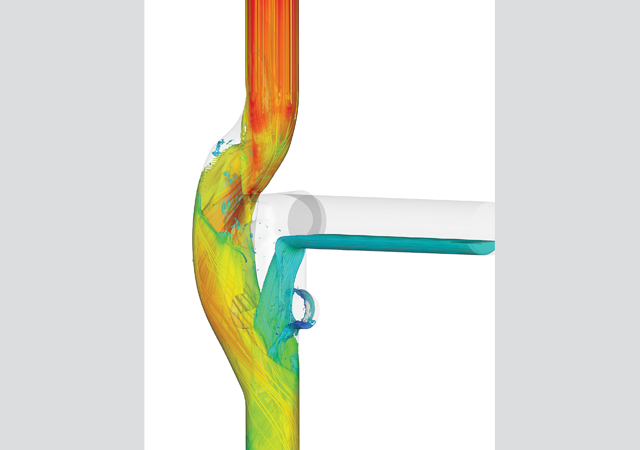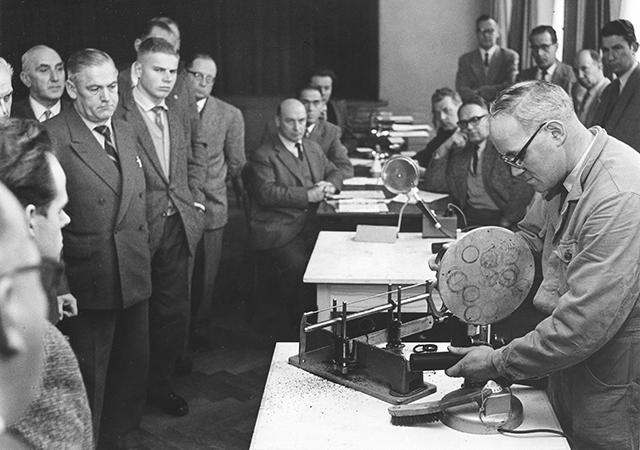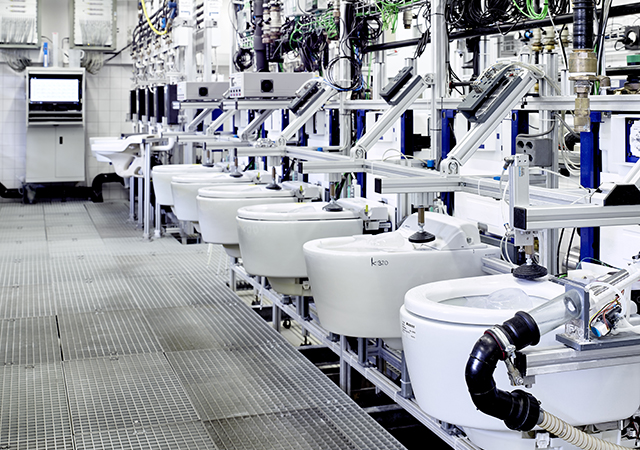Geberit: Redefining drainage engineering
Geberit has played a crucial role in driving the transition from traditional materials to plastics in the building drainage sector. Its pioneering move in the mid-1950s met with initial scepticism which the Swiss sanitary solutions provider addressed by demonstrating the benefits of PE through R&D and training, says LOUISE PITT*.
01 October 2024
Geberit, a renowned Swiss sanitary solutions provider, has played a pivotal role in shaping the drainage sector. One of its most significant contributions has been driving the transition from traditional materials to plastics, particularly polyethylene (PE). This shift has had profound implications for the design, construction, and maintenance of drainage systems in buildings.
Before Geberit’s innovations, traditional materials like cast iron, copper, and fibre cement were the norm in water systems. These materials, while durable, had several drawbacks, including susceptibility to corrosion, heavy weight, and complex installation processes. Geberit recognised the potential of PE as a superior alternative.
PE for drainage
Geberit’s early adoption of PE for water systems was a bold move. The company started using PE plastic in the mid-1950s, making it one of the pioneers in establishing a material that has become an integral part of the sanitary world today.
In 1966, Geberit broke new ground: The Swiss company introduced its own range of fittings and pipes – made not from the traditional materials such as cast iron, copper or fibre cement, but from pitch-black plastic, polyethylene.
PE is ideally suited for sanitary applications. It is resistant to almost all chemicals, withstands both hot water and frost, and is impact-resistant as well as corrosion-free. Additionally, the material is extremely easy to process.
 |
|
Computer simulations were used to calculate the water and air circulation in the waste water pipes to optimise the shape and size of pipes. |
In terms of drainage, PE offers a broad range of applications – from residential to sophisticated laboratory installations. However, the company faced initial scepticism as craftsmen and engineers generally regarded plastics as inferior – as in the 1960s, PE was still a relatively new material.
Wastewater experts
Geberit has been a pioneer in sanitary technology for over a century, driving significant advancements in the industry. The company has conducted extensive research and development in areas such as plastics processing and wastewater hydraulics, leading to groundbreaking innovations.
One of Geberit’s most notable achievements was the development of the first plastic cistern in 1952, which marked a significant departure from traditional materials and paved the way for the widespread adoption of plastics in sanitary products.
The company then conducted pioneering work on pipes and fittings. It intensively researched processing technology and overcame experts’ scepticism, who deemed PE unsuitable for injection moulding. After numerous trials, Geberit technicians succeeded in injection moulding the material.
Simultaneously, Geberit undertook fundamental research on building drainage, as knowledge of wastewater hydraulics was still nascent in the 1960s. At its headquarters in Rapperswil-Jona, engineers and hydraulic specialists began comprehensive experiments to study water and air circulation in pipes and to continuously improve their performance. Geberit experts had access to a seven-storey wastewater experimentation facility, one of the few in Europe.
Training initiative and market penetration
The company emerged as a leader in building drainage technology. However, technical expertise alone was not enough to conquer the market: Geberit subsequently organised hundreds of training sessions across Europe, demonstrating the robustness and versatility of PE products on-site and acquainting thousands of installers with PE pipes and their processing.
 |
|
Geberit officials show customers how to connect plastic pipes using a welding mirror in the 1960s. |
In its own training centres, later known as Geberit Information Centres (GIC), Geberit constructed wastewater systems with transparent pipes to display comparison installations. The extensive training initiative was highly effective: Plumbing professionals quickly recognised the assembly benefits of PE, such as the various connection techniques and the simplicity of handling. By the late 1980s, PE pipes had largely replaced traditional materials for drainage pipes in many countries.
Continuous optimisation
In addition to materials innovation, Geberit has also focused on improving the performance and efficiency of sanitary systems. The company has developed noise-reducing technologies to enhance user comfort and has invested in research to optimise water flow and hydraulics.
From the 1950s, hydraulic and acoustic expertise became particularly important as “noise control” (as it was called at the time) in domestic construction, gained significance. Due to generally poor construction quality and the trend towards denser living, the noise problem in sanitary rooms intensified. Geberit developed technologies such as an “absolutely noiseless” bath fitting and continuously improved the sound insulation of cisterns.
In the 1970s, Geberit provided architects, planners, and sanitary installers with practical tips for the acoustic design of pipelines. At the same time, sound tests with pipes were conducted in the company’s own experimental facility. The development was time-consuming: in 1989, Geberit launched PE-Silent, the first pipeline system for welding with integrated sound insulation.
While the sound insulation functioned, the processing of the pipes was quite complex for the installer. The breakthrough came nearly 10 years later with Silent-db20, which led to improved sound protection through the addition of stone powder to the plastic. The system includes insulated pipe clamps and was later supplemented by the push-fit systems Silent-PP and Silent-Pro.
In the early 1970s too, Sovent, a revolutionary product, was launched: This fitting enhanced the efficiency of wastewater downpipes in high-rise buildings.
The company further developed Sovent into the SuperTube system, where water management was optimised to the extent that no ventilation pipes were required – thus saving space.
Geberit’s expertise in hydraulics and building acoustics will be showcased this year with Silent-Pro SuperTube. This product, used in lower buildings like multi-family homes, is both space-saving and sound-insulating.
Drinking water systems
Geberit has also made significant strides in drinking water systems – a market it entered in 1990 with multilayer pipes.
The multilayer pipes – featuring plastic on the outside and inside with a metal layer in between – were a young technology in the sanitary industry at the time. These pipes combined the advantages of both materials: the stability of metal and the corrosion resistance and easy handling of plastic.
Geberit was one of the pioneers when it launched the multilayer pipe system Mepla in 1990. Before Mepla, Geberit was primarily active in flushing technology and water disposal. As a recognised plastic processor, the step to an innovative plastic pipe was only logical.
Geberit continuously improved the system, first developed by a company from western Switzerland. Initially, Mepla pipes were connected with metal screw fittings. This was cumbersome and time-consuming, especially for larger pipe diameters. Geberit’s engineers applied the proven principle of press fittings to plastic pipes and introduced press fittings for multi-layer composite pipes in 1992 – a world first. The industry was initially very sceptical of the press fittings – made of metal at first, later plastic.
Sanitary installers had to be convinced of the new technique of pressing plastic pipes. Geberit achieved this with comprehensive training and demonstrations of the easier and faster installation technique.
Arguments such as cost-effectiveness and reliability were very well received by the experts. Today, the Geberit Mepla piping system is an established product for drinking water installations and is also used for heating applications.
Research
Geberit’s commitment to innovation is evident in its ongoing research and development efforts. The company currently has 400 employees dedicated to technology and innovation, and invests CHF80 million ($94.6 million) annually – around two to three per cent of its turnover in this area. This substantial investment demonstrates Geberit’s dedication to staying at the forefront of the sanitary technology industry.
The globally operating Geberit Group, which is celebrating its 150th anniversary this year, is a European leader in the field of sanitary products. Headquartered in Rapperswil-Jona, Switzerland, the group’s production network encompasses 26 production facilities, of which four are located overseas. With around 11,000 employees in approximately 50 countries, Geberit generated net sales of CHF3.1 billion ($3.67 billion) in 2023.
* Louise Pitt is Head of Marketing & Communication (Gulf Office) at Geberit International Sales.
- Geberit: Redefining drainage engineering
- New Tadano delivers improved safety
- JuffaliTrucks sets new standards in transportation
- CDE unveils a new generation filter press
- Liebherr adds new MK model to mobile range



